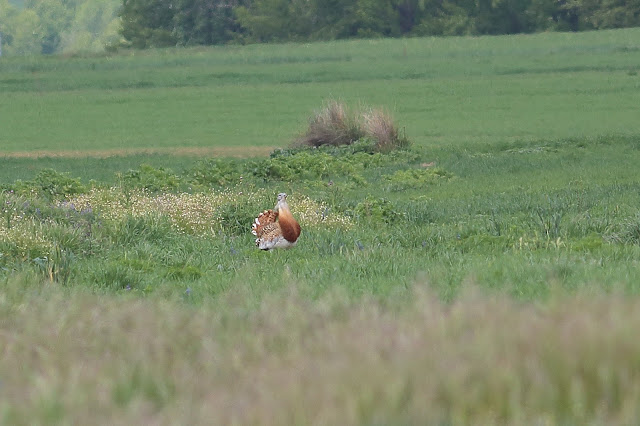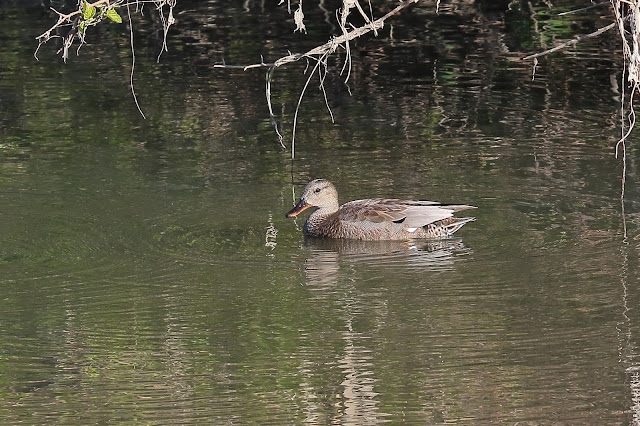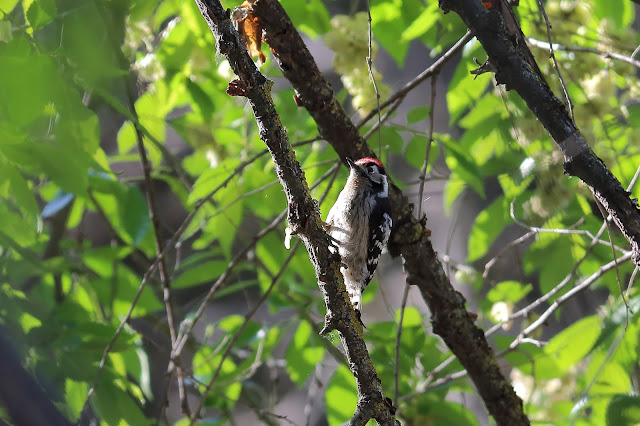Hola una vez más.
Hi again.
Hi again.
En el siguiente enlace podéis ver nuestros próximos viajes fotográficos y de observación de aves y mamíferos nacionales y al extranjero. Espero que os gusten y os animéis a venir conmigo. Una experiencia que nunca olvidareis. Estos viajes están condicionados a la situación en que se encuentren los destinos con respecto a la pandemia del coronavirus.
In the following link you can see our next national and foreign Birds and Mammals photographic and observation trips. I hope you like them and I encourage you to come with me. An experience that you will not forget. These trips are conditioned to the situation in which the destinations are with respect to the coronavirus pandemic.
En esta ocasión os muestro algunas de las aves que pude fotografiar en una excursión privada de un día por la comunidad de Madrid. El cliente me paso una relación de especies que quería observar y que nunca antes había visto y yo le preparé un itinerario adaptado para ver la mayor cantidad de especies que él me había indicado.
This time I show you some of the birds that I was able to photograph on a private day trip through the community of Madrid. The client gave me a list of species that he wanted to observe and that he had never seen before and I prepared an adapted itinerary to see as many species as he had indicated.
Al final de la jornada consiguió ver 5 especies nuevas para él que fueron el mirlo acuático europeo (Cinclus cinclus), bigotudo (Panurus biarmicus), gorrión chillón, cernícalo primilla (Falco naumanni) y torcecuello euroasiático (Jynx torquilla). Las dos últimas especies no pude fotografiarlas pero el resto si.
At the end of the day he managed to see 5 new species for him, which were the White-throated
Dipper, Bearded
Reedling, Rock Sparrow, Lesser Kestrel and Eurasian Wryneck. The last two species I could not photograph but the others I could.
No vimos sisón común (Tetrax
tetrax), carricero tordal (Acrocephalus arundinaceus) ni búho real (Bubo bubo). En el caso de los primeros, en el mejor sitio para verles estaban, en pleno mes de abril, arando el terreno en barbecho que es donde más suelo verlos en época de cría. Es una barbaridad que hagan una cosa así con la destrucción de nidos que ello conlleva y más cuando hay aves que están sufriendo un declive tan drástico como el sisón común (Tetrax tetrax).
We did not see Little Bustard , Great
Reed Warbler and Eagle Owl. In the former case, they were in middle of Aprilin and in the best place to see them plowing the fallow land, which is where I most often see them during the breeding season. It is outrageous that they do such a thing with the destruction of nests that this entails and even more so when there are Birds that are suffering such a drastic decline as the Little Bustard.
Por la mañana estuvo nublado pero la tarde fue soleada.
In the morning it was cloudy but the afternoon was sunny.
In the morning it was cloudy but the afternoon was sunny.
Mientras buscábamos al mirlo acuático europeo (Cinclus cinclus) pudimos ver algunos machos de roquero solitario (Monticola
solitarius).
While we were looking for White-throated
Dipper we could see some males of Blue Rock
Thrush.
Un grupo de grajillas occidental (Corvus
monedula) estaban recogiendo material para sus nidos.
A group of Eurasian
Jackdaw were collecting material for their nests.
Un macho de lavandera cascadeña (Motacilla
cinerea).
A male Gray Wagtail.
Hembra.
Female.
Y por fin pudimos contemplar a placer a un mirlo acuático europeo (Cinclus cinclus).
And finally we were able to contemplate very well a White-throated
Dipper.
Un bonito macho de colirrojo tizón (Phoenicurus
ochruros).
A beautiful male Black
Redstart.
Aunque vimos varios gorriones chillones (Petronia
petronia) éste fue el que más cerca tuvimos.
Although we did watched several Rock Sparrows this was the closest we had.
Después nos trasladamos hasta la zona esteparia en busca de los sisones comunes (Tetrax tetrax). Lo primero que vimos al llegar fue a esta hembra de aguilucho cenizo (Circus
pygargus).
Then we move to the steppe area in search of the Little Bustard. The first thing we saw upon arrival was this female Montagu's Harrier.
Ya se podían ver algunos abejarucos europeos (Merops
apiaster) buscando insectos por los sembrados.
Some European Bee-eaters could already be seen searching for insects in the fields.
En total vimos 5 gangas ortega (Pterocles
orientalis). Una pareja en vuelo y en la foto dos machos y una hembra que es la que está más a la derecha.
In total we saw 5 Black-bellied
Sandgrouses. A couple in flight and in the photo two males and a female who is the one on the right.
También había varios machos de avutarda común (Otis
tarda) pavoneándose.
There were also several male Great Bustard strutting.
Incluso dos de ellos haciendo la rueda. Que maravilla.
Even two of them displaying. Awesome.
Solo vimos cuatro hembras. Dos en la fotografía y otras dos más lejanas y por separado.
We only saw four females. Two in the photograph and two more distant and separately.
Esta cogujada común (Galerida
cristata) estaba muy atareada con la construcción de su nido.
This common Crested
Lark was very busy building its nest.
Después fuimos por varias lagunas del Parque Regional del Sureste y lo más destacado fue poder ver a un macho de bigotudo (Panurus biarmicus).
Then we went through several lagoons of the Southeast Regional Park and the highlight was being able to see a male Bearded
Reedling.
Mira que son bonitos.
They are very beautiful.
Habían llegado los carriceros comunes (Acrocephalus scirpaceus) pues los escuchamos y vimos en varias lagunas pero los carriceros tordales (Acrocephalus arundinaceus) o no cantaban o no habían llegado aun. En la foto dos machos de pato colorado (Netta
rufina) y una hembra, la del medio.
Reed Warbler had arrived as we heard and saw them in several lagoons but Great
Reed Warbler either did not sing or had not yet arrived. In the photo two male Red-crested
Pochard and a female on the middle.
Un macho de ganso del Nilo (Alopochen
aegyptiaca). Esta especie invasora es cada vez más abundante.
A male Egyptian Goose. This invasive species is becoming more and more abundant.
Una pareja de porrones europeos (Aythya
ferina). El macho es el que está delante.
A pair of Common
Pochard. The male is the one in front.
Otra pareja.
Another pair.
Momentos íntimos.
Intimate moments.
Una pareja de ánades frisos (Anas
strepera).
A pair of Gadwall.
El macho ya estaba mudando a plumaje de eclipse. Un poco temprano me parece a mi.
Male was already molting into eclipse plumage. A little early seems to me.
Vimos una pareja de picos menores (Dryobates
minor). En la foto un macho.
We saw a pair of Lesser Spotted
Woodpecker. In the photo the male.
La hembra.
The female.
Me extrañó ver a esta pareja de cormoranes grandes (Phalacrocorax
carbo) subadultos con pautas reproductoras. Incluso han construido un nido como se puede apreciar en la fotografía.
I was surprised to see this pair of sub-adult Great Cormorants with breeding behavior. They have even built a nest as you can see in the photo.
Y para finalizar con el relato, os muestro a esta bonita pareja de somormujos lavancos (Podiceps
cristatus).
And to end the story, I show you this beautiful pair of Great Crested Grebes.
Si queréis suscribiros a este blog de los viajes que hacemos pincha en el siguiente enlace: Suscribirse y haz clic en ¿ Quieres suscribirte a nuestro blog?
If you want to subscribe to this post about the trips we do, click on the following link: Susbcribe and click on: Do you want to subscribe to our blog?
Espero que os haya gustado y hasta pronto.
I hope you like it and see you soon.











































Preciosas fotos, el bigotudo es espectacular. Gracias por compartir.
ResponderEliminarMuchas de nadas.
EliminarGracias a ti por comentar y visitar los blogs.
saludos,
Luis
El bigotudo es muy precioso.
ResponderEliminarSI, Espen es una ave muy bonita, una de mis preferidas.
ResponderEliminarSaludos,
Luis
Que interesante todo este blog. Hay varias especies que aún no vi. Me puedes decir donde puedo ver más de tus publicaciones, instagram? O pag personal? Haces salidas ornitologicas? Gracias
ResponderEliminar